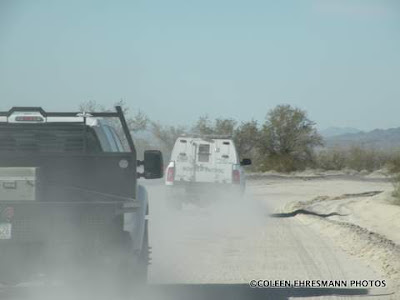
She shared their Organic Date Farm is 40 acres, about 3000 trees. (The date palms I photographed and posted on the other post are NOT part of their Organic Date Farm.)

It takes about 15 years for the trees to reach maturity. Trees will produce small dates beginning in year 5. I think she said when all their trees reach maturity, they hope to harvest 70,000 pounds of dates.

yard decor
She had 3 grades of pitted and non pitted dates for sale. We sampled before we bought. YUM! She also offered date shakes. It was 10 AM so we did not get one, but if you have not tasted a date shake, I highly recommend one. They are amazingly very good.

The smaller dates usually have less moisture. You might think, moisture? We tasted the jumbo dates. They were so plump and tasty. We were both surprised at the taste and texture.

She also shared how the dates are harvested. As the dates begin to grow on the cluster stem (sort-of-like grapes) the center of the cluster is removed to allow more room for the other dates to grow. This is done by hand. As the dates on the cluster stem grow, more dates are removed until only 7 or so dates remain on the strand.
photo from Wikipedia
This photo helps explain how the dates grow and the term strand. Dates are removed by hand so that only 5 to 7 dates will grow to maturity on each strand.
A bag is placed over the dates at this point. (We think the bag is to keep birds away from the ripening fruit.)

As the dates reach full maturity, the bags are opened or removed and trays are placed on the ground under the trees. The trees are shook. The ripe dates fall off the stem onto the trays. The trays are moved to buildings where they are graded by size and placed in packages for consumers. Very labor intensive.
* * * * * * * * *
On another note, we have been geocaching on the Barry M. Goldwater Range. This is a military bombing and gunnery range. Vehicles are to stay on the approved roads as unexploded devices could be throughout the other areas. We needed a special permit for this adventure. There are 14 items on the permit that we must read and initial. #1 and #2 refer to "property damage and permanent, painful, disabling and disfiguring injury or death due to high explosive detonations from falling objects such as aircraft, aerial targets, live ammunition, missiles, bombs, etc. There are also physical injury and health dangers from ground and aerial LASER and other electromagnetic emissions."

We have not seen many interesting, communicative signs. This one is posted on the northern perimeter of the area. We have heard jets/planes every day. On Wednesday, one was flying close to the ground, closely, but until I could get the camera out, it was gone. Hubby heard loud booms (guns? tanks?) on Tuesday. Again, we did not see anything.
The air force uses the eastern part of the BMGR and the marines use the western area, where we are geocaching. There is also a nature preserve on the range. No ATVs are allowed. AND there is no littering or garbage along the roads.

Today we passed this radar site. It is the first one we have seen. We heard from others that there is at least one practice bombing site with old planes and tanks. We have not seen it. We also heard there was a mock-up town used for practice. We have not seen it, either.

We have seen or met Border Patrol vehicles each day we have traveled on the BMGR. Today, four units driving very fast passed us, heading south. Yesterday, when we were as far south as we will be in this area, a Border Patrol stopped and asked how we were doing and chatted with Hubby for a few minutes. Today? Everyone was on a mission. We saw a total of 7 trucks/units today, at different times and on different roads. Hmmmm.

I was watching this dust cloud in the east. More than likely it came from the farmland farther east.


Yesterday, when we were farther south, we did see some saguaro cactus. In fact, many saguaros. Today we were in the northern part of the BMGR where the ocotillos were prominent. Yesterday, we were 5 miles from the Mexican border.

I was surprised to see several of them blooming. In our area, they do not bloom until March or so.
The temperatures have been so pleasant on this trip. Last year when we were here, it was 80º by noon and the two of us were tired by noon. There has also been a breeze each day we have been out. That helps. We have one more day of serious desert geocaching...on this trip.

The ocotillo are blooming here in Gold Canyon. I think it is due to the rain we had recently. See you guys soon. :)
ReplyDelete